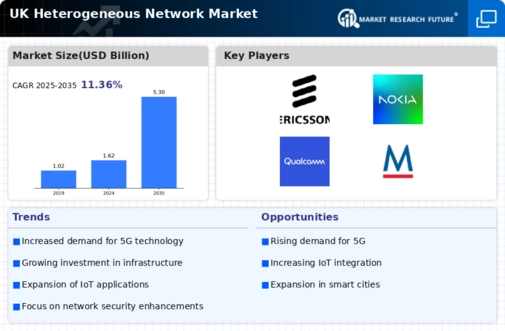Emergence of Smart Technologies
The emergence of smart technologies is significantly impacting the heterogeneous network market. With the proliferation of smart devices and applications, there is an increasing need for networks that can support diverse communication protocols and data types. The UK is witnessing a rapid growth in smart home and industrial IoT applications, which are projected to reach a market size of £15 billion by 2025. This growth necessitates the development of heterogeneous networks that can accommodate various devices and ensure reliable communication. As businesses and consumers adopt smart technologies, the demand for flexible and scalable network solutions is likely to increase, thereby driving the heterogeneous network market forward.
Increased Cybersecurity Concerns
The rise in cybersecurity threats is prompting a shift in focus within the heterogeneous network market. As organizations adopt more complex network architectures, the potential vulnerabilities increase, necessitating robust security measures. The UK government has reported a 20% increase in cyber incidents over the past year, underscoring the urgency for enhanced security protocols. This trend is leading to greater investment in cybersecurity solutions that can seamlessly integrate with heterogeneous networks. Companies are prioritizing the implementation of advanced security frameworks to protect sensitive data and maintain operational integrity. As a result, the heterogeneous network market is likely to see a surge in demand for security-focused solutions, which could reshape the competitive landscape.
Growing Adoption of Cloud Services
The growing adoption of cloud services is a pivotal driver for the heterogeneous network market. Businesses are increasingly migrating their operations to the cloud to enhance flexibility, scalability, and cost-efficiency. Recent data suggests that the UK cloud computing market is expected to reach £40 billion by 2025, reflecting a robust shift towards cloud-based solutions. This transition necessitates the integration of heterogeneous networks to ensure seamless connectivity between on-premises and cloud environments. As organizations seek to optimize their IT infrastructure, the demand for heterogeneous network solutions that facilitate efficient cloud integration is likely to rise. This trend not only supports operational efficiency but also drives innovation within the market.
Advancements in Network Infrastructure
Technological advancements in network infrastructure are significantly influencing the heterogeneous network market. The deployment of next-generation technologies, such as 5G and edge computing, is transforming how data is transmitted and processed. These innovations enable faster data transfer rates and lower latency, which are crucial for applications like autonomous vehicles and smart cities. According to recent statistics, the UK is expected to invest over £30 billion in 5G infrastructure by 2025, highlighting the commitment to enhancing network capabilities. As these advancements continue to evolve, they create new opportunities for service providers and enterprises to leverage heterogeneous networks, ultimately driving market growth.
Rising Demand for Enhanced Connectivity
The heterogeneous network market is experiencing a notable surge in demand for enhanced connectivity solutions. This demand is driven by the increasing reliance on digital services across various sectors, including healthcare, finance, and education. As businesses and consumers seek seamless connectivity, the heterogeneous network market is poised to expand. Recent data indicates that the UK telecommunications sector is projected to grow by approximately 5.5% annually, reflecting the need for robust network solutions. The integration of diverse technologies, such as 5G, Wi-Fi 6, and satellite communications, is essential to meet this demand. Consequently, service providers are investing heavily in heterogeneous network infrastructures to ensure reliable and high-speed connectivity, thereby fostering growth in the market.















Leave a Comment